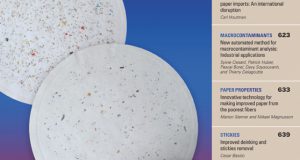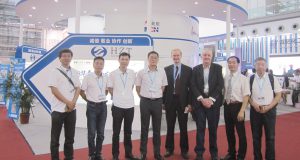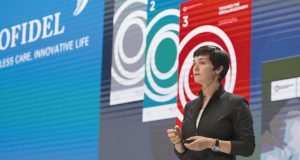KENTARO TAJIRI AND THOMAS WISCHEROPP
For years, Klingele Papierwerke in Weener, Germany, had suffered from less than ideal conditions on its first top dryer fabric, including short fabric life and serious sheet moisture profile variation. The mill had used “spot cleaners” and off-line washes, yet was not satisfied with running and maintenance costs and the detrimental effect of stickies on sheet profiles and paper quality.
 This type of system—traversing “spot-cleaners” using high-pressure water and air to force contaminants out of the fabric and maintain a working permeability—is common in many mills. While there have been improvements to the systems available on the market, many issues still remain.
This type of system—traversing “spot-cleaners” using high-pressure water and air to force contaminants out of the fabric and maintain a working permeability—is common in many mills. While there have been improvements to the systems available on the market, many issues still remain.
First, the jets operate on only a very small portion of the fabric at a time, meaning the interval before the same area is cleaned again can be as much as 20 minutes or so. Further, the use of high-pressure jets is not ideal on any fabric. Some mills report premature damage to the integrity of the fabrics and even to the fabric rolls and framework, which must be cleaned from corrosion. In addition, foreign material is often forced deeper into the fabric, ultimately degrading the yarn interstices, reducing fabric life. There is also a high cost associated with running the water and air systems, maintaining the equipment, and regularly assessing that the cleaner is operating effectively.
Searching for a different solution, the mill learned of a felt cleaning system developed by Aoki of Japan, then being used in about 50 Japanese installations. In 2012, Klingele Papierwerke purchased the first AOKI Cleaner to be delivered into Europe.
“We had a decision to make,” explains Mill Manager Thomas Wischeropp. “Should we persist with the standard cleaning systems, with their high demand on utilities and manpower, or try the Aoki system, which promised to minimize effort and downtime and maintain a quality sheet? Maybe the answer is obvious now, yet (at the time) systems common in the marketplace had been improved, while the Aoki product was an unknown entity.”
THE AOKI APPROACH
In 2004, Aoki of Japan’s chief designer, Mitsuo Aoki, determined that effective fabric cleaning should have two main features. First, it should apply to the full width of the fabric and be continuous. Second, the principle should be to prevent contaminants achieving significant ingress in to the fabric. In short, cleaning must be gentle, consistent, proactive, and continuous.
The outcome of an intense two-year development program was the AOKI Cleaner: a purely mechanical system that is now commonplace in Japan on a range of furnishes and speeds. It services brown grades and fine papers alike and can be run up to 2,000 m/min.
The AOKI Cleaner (Fig. 1) uses a principle well-known to papermakers: a foil effect that induces the surface contaminants to gather onto a cleaning blade and are thus gently coaxed from the fabric surface. The blade oscillates  slowly sideways to assist this function and the foils are made from a material specially designed by Aoki to do no damage to the fabric yarns, whether round, flat, “spiral” or even twisted multifilament.
slowly sideways to assist this function and the foils are made from a material specially designed by Aoki to do no damage to the fabric yarns, whether round, flat, “spiral” or even twisted multifilament.
 The cleaner may have up to six foils, depending on the nature and extent of the contamination, machine speed, and fabric design. Typical applications use three or four foils that guide contaminants into a saveall designed for easy cleaning during shutdown.
The cleaner may have up to six foils, depending on the nature and extent of the contamination, machine speed, and fabric design. Typical applications use three or four foils that guide contaminants into a saveall designed for easy cleaning during shutdown.
The real difference to the papermaker is visible on close inspection at shutdown. At left is a typical example from a Japanese mill, running a 5-m deckle width at approximately 600 m/min. Figures 2 and 3 show the same fabric before and after the installation of the AOKI Cleaner.
The KLINGELE EXPERIENCE
The Klingele mill installed its first unit on PM 2 in the first top position. “From the start, we saw far greater consistency in sheet profiles (Fig.4) and it was evident the Cleaner prevented any significant ingress of contaminants into the fabric. Our first fabric stayed on the machine for nine months compared to the previous average of three, which paid for the new equipment,” says Wischeropp.
 As a result of the initial success, Klingele made investments in two more units: for the second top and third bottom positions on PM 2, which runs up to 1,000 m/min. Aoki supervised the installation and remained on site to ensure the blade settings achieved maximum efficiency. “This will be an ongoing investment for us. We have already made cost savings that outweigh the initial investment,” Wischeropp says.
As a result of the initial success, Klingele made investments in two more units: for the second top and third bottom positions on PM 2, which runs up to 1,000 m/min. Aoki supervised the installation and remained on site to ensure the blade settings achieved maximum efficiency. “This will be an ongoing investment for us. We have already made cost savings that outweigh the initial investment,” Wischeropp says.
The mill saw other benefits, he adds. “We recorded fewer paper breaks attributable to the dryer section and improved paper quality. In 2014 we had a significant reduction in complaints of sheet contamination, and since we installed the two additional cleaners we have had no more breaks caused by sticky contamination, with claims reduced from 17 to only 6 per year, and those being unrelated to stickies.”
There has also been an environmental bonus. “We have no need for dryer fabric cleaning chemicals and have thus maintained a safe working environment for our crews,” Wischeropp notes. “They also gave us positive feedback that this system was superior to the spot cleaner concept we had used before.”
Kentaro Tajiri is a manager with Matsubo Corporation, and Thomas Wischeropp is mill manager with Klingele Papierwerke, Germany.Fig. 1: The AOKI Cleaner
Fig. 2: Before installation of the AOKI Cleaner.
Fig. 3: One month after installation.
Fig. 4: Klingele Weener mill CD Sheet Profiles (mid-life).
 Paper 360
Paper 360


